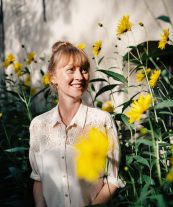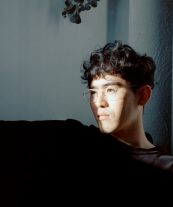COMMON GROUNDS: Christien Meindertsma x Yuta Ikeya
 1
1
 2
2
— ‘Technology might enrich the way we live with other beings’
Christien Meindertsma explores the life cycles of materials and products through immersive research. She aims to shed light on the often-overlooked processes that shape our perceptions, and reassess their current value. She has won several Dutch Design Awards: Young Designer in 2008, Product + Future Award in 2016, and in 2023, her collaboration with Gemeente Rotterdam was awarded Best Commissioning. Christien selected Yuta Ikeya to join the DDA spotlight ranks, a Japanese designer and engineer who challenges the purpose of technology in relation to the natural world.
Poetry in motion
Christien: “I find it so inspiring that your work is about technology, yet is still so poetic. It’s complex and delicate, with layers that aren’t immediately obvious–and I think that’s important. Yet not many people can achieve that. I’m a material-based designer myself, without any technological talent. But I do know things like how wool works and I know how to make things by hand. What would happen if you approached traditional craft using today’s technology? I believe it’s crucial that designers understand how to transform materials, to create new tools. Our whole world changes as a result.”
Yuta: “I always try to incorporate some element of technology into my work, given my background as an engineer. When we think about topics like sustainability, people often look to the past and shy away from technology, but my mind doesn’t work that way. I want to explore a space where technology is pure and innocent, and where it can enrich our coexistence with other living beings.”
Process
Yuta: “My current challenge is that the more artistic design work I create will now remain within gallery spaces, and from there it can be difficult to truly influence people’s thinking. I find myself questioning if my work is impactful enough, particularly as it pertains to addressing the climate crisis.”
Christien: “The way you’re expressing your thinking right now, is probably the freest you’ll ever be, because at this point, you don’t have to make any compromises. The question now is, where do you want to take your work from here? For twenty years I’ve struggled with being labeled as an artist, when I see myself as a product designer. But I’ve come to realize that I am not a ‘typical’ product designer–I’m not interested in mass production, and I feel much more at home in a museum setting.”
Location
Yuta: “Your projects are location-based and when we look forward to the future of humanity, I believe we should embrace a location-specific way of making. There is something inherently different about it–far removed from the focus on productivity, efficiency or scale.”
Christien: “When you work in one location, you have to just work with whatever resources you can get. When I started my wool project, it was unclear whether or not it was waste wool, but I saw that uncertainty as a great starting point. There is a tension, a risk that makes it exciting.You can’t just develop the process that informs your project, the connections you make with new people by sitting at home. The research itself becomes a journey–an adventure that enriches you. The design process is like following a river: I know it will lead me to a fairly specific place, but I wouldn’t know how to dig the canal to get me there.”
Soul searching
Christien: “I’ve recently been reflecting on the idea of materials having a soul. In Roman times wool was considered to have a soul, having come from living animals. Today, in the Western world, we’ve reduced everything around us–even ourselves–to mere monetary value, which I find quite sad. People often ask me: “Who cares where the wool comes from if it’s more expensive?” But to me, it matters deeply. Working with the Rotterdam flock, and seeing their surroundings influence their fleece, makes the whole value proposition feel much more natural.”
Yuta: “In Japan, children love collecting insects, it’s part of the culture. As we grow older we usually lose that fascination, but somehow I kept mine. My project, “Metamorphonic”, features silkworms, considered to be divine beings in Japan. This project explores what humans can gain from a relationship with these insects when we stop trying to control them or extract their silk. After years of domestication, this particular species is now entirely dependent on humans. So, what if we simply let them live out their full lifecycle? In my project I give them agency through sound, allowing their movements to create ambient music. It’s not a critique of silk-farming as such, but rather an invitation to ask: isn’t this a better relationship?”
Christien: “You can also question whether we need sheep at all. The original species didn’t require shearing, but today’s animals are wholly dependent on us. So how can we ensure their lives are comfortable enough for them to be wool producers?”
Evelien Reich has served as chair of the Young Designer jury of Dutch Design Awards for the past three years. This year, she interviews the Young Designers that DDA has selected from the archives, as well as the emerging talents they choose to spotlight. All twenty Young Designers, both past and present, will showcase their work at the 2024 DDA exhibition during Dutch Design Week in Eindhoven, taking place 19 to 27 October.
Discover the work of Christien Meindertsma and Yuta Ikeya and all the other Young Designers of the Past & Present in the DDA24 exhibition at Microlab Hall on Strijp-S, during Dutch Design Week. From 19 to 27 October 2024 in Eindhoven.